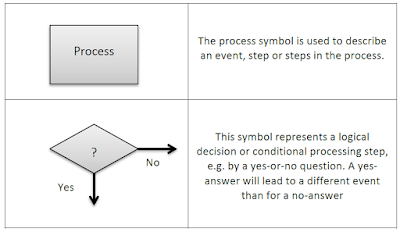Figure 1 below.
Figure 2 shows an example of how the process maps icons can be used together in order to develop a process diagram. Short arrows and boxes of the same sizes are recommended to increase the readability and consistency of the diagram. The texts used to describe the actions are preferably short, direct and only contains relevant information
As the first stage of mapping a process, recommends developing an outline of steps used for conducting the process and then evaluating the list to see which steps can be consolidated in order to symbolize a generic process. When the list is complete and correct, a whiteboard and sticky notes representing each action can be used to create an initial map. This method makes it easy to move elements around and increases the readability. The process map is then drawn on a paper and the goal is that the understanding of the process and its steps should be so clear and detailed that anyone that draws it will develop the same map. Variations are more likely to occur if the map is longer than two pages or 80 icons, but the basic process should be the same. When the map is established, it should be reviewed to validate its completeness and level of detail to make sure that everyone shares the same understanding of the process. If it is approved, a digital process map can be created using graphic applications and programs. This is later verified and approved by the interviewees and the client. When using the map to improve existing processes, remapping of the process should be performed in order to simplify and remove unnecessary steps or activities that add little or no value. this should be performed more than once in order to make significant process improvement breakthroughs, and not only find the obvious redundancies and inefficiencies.









No comments:
Post a Comment